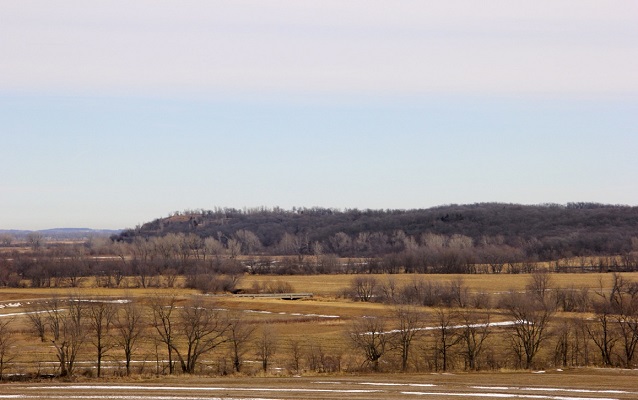Last updated: December 30, 2021
Place
Leary Site

Photo by Lance M. Foster
Lewis and Clark NHT Visitor Centers and Museums
William Clark was the first recorded visitor to Leary Site. On July 12, 1804, he wrote in his journal:
“. . . after going to Several Small Mounds in a leavel plain, I ascended a hill on the Lower Side, on this hill, Several Artificial Mounds were raised; from the top of the highest of those Mounds I had an extensive view of the serounding Plains, which afforded one of the most pleasing prospects I ever beheld, under me a Butifill River of Clear water of about 80 yards wide Meandering thro a level and extensive Meadow, as far as I could See, the [view of the] prospect Much enlivened by the fine Trees & Shrubs which [was] is bordering the bank of the river, and the Creeks & runs falling into it,- . . . I observed artificial mounds (or as I may more justly term Graves) which to me is a strong indications of this Country being once Thickly Settled. (The Indians of the Missouris Still Keep up the Custom of Burying their dead on high ground.)”
Clark imagined (correctly) that these mounds were constructed for human burial. The mounds are believed to have been constructed by the Oneota people. The site is significant because it shows the expansion of the Oneota during the late Prehistoric period.
While at the Leary Site, Corps member Alexander Willard was charged with lying down and sleeping while on guard duty. He was sentenced to receive 100 lashes to be broken up and given at four different times. The Corps of Discovery left the site early on July 13 to continue their westward trek.
Sources
http://krex.k-state.edu/dspace/handle/2097/15695
Leary Site is a High Potential Historic Site on the Lewis and Clark National Historic Trail.
Clark visited this site on July 12, 1804, and observed raised mounds that were American Indian grave sites. He noted that “after going to Several Small Mounds in a leavel plain, I ascended a hill on the Lower Side, on this hill, Several Artificial Mounds were raised; from the top of the highest of those Mounds I had an extensive view of the serounding Plains, which afforded one of the most pleasing prospects I ever beheld, under me a Butifill River of Clear water of about 80 yards wide Meandering thro a level and extensive Meadow, as far as I could See, the [view of the] prospect Much enlivened by the fine Trees & Shrubs which [was] bordering the bank of the river, and the Creeks & runs falling into it, [...] I observed artificial mounds (or as I may more justly term Graves) which to me is a strong indications of this Country being once Thickly Settled.” A court martial was convened at the Corps’ nearby camp that same day. Alexander Willard was charged and punished for sleeping while on guard duty.
Located along the Big Nemaha River south of present-day Rulo, Nebraska, the Leary Site National Historic Landmark is within the boundaries of the Iowa Reservation. The hill summited by Clark remains intact and is crested by three burial mounds. The mounds and surrounding area comprise the archeological site of an extensive village formerly inhabited by the Oneota Tribe.
